Microsoft BUILD: Windows 8, A Pre-Beta Preview
by Brian Klug & Ryan Smith on September 13, 2011 12:05 PM EST- Posted in
- BUILD
- Windows
- Microsoft
- Windows 8
- Trade Shows
Mobile Experience Side
Coming from the smartphone side of things, I really see many shades of WP7 inside Windows 8. That’s actually dramatically understating the state of things - the core of what we’ve been shown of Windows 8 that’s new literally is either adopted from or directly analogous to much of WP7.
It doesn’t come as a surprise to me at all that the desktop Windows experience is moving in this direction, (and it seems as though the Xbox 360 interface will follow shortly). The positive result is that Windows 8’s touch experience feels much closer to the ground-up approach Android Honeycomb or iOS have taken than the than the “Tablet-Edition” versions of Windows XP and the tablet integration in Vista and 7. I used a UMPC and remember Origami and how that application lived as its own standalone mode of operation as an application within windows. What Windows 8 is the inverse - Windows now lives inside a Metro-themed Start screen that looks like WP7 for the desktop. Or at least it does in this demo we’ve been shown currently.
The tablet experience is now absolutely on par with modern mobile OSes - sure there are a few more things that need to be included, but the foundation is there for Windows to suddenly become more than an OS that also can do touch-based interaction.
IE 10
Microsoft has been actively promoting IE 10 since MIX 11, with two platform previews so far, and IE 10 is an integral part of Windows 8 both as a browser and as a runtime for HTML based Metro applications. We won’t go into exacting detail about what’s new and interesting inside IE10, beyond mentioning that it improves upon IE 9’s GPU acceleration and improves web compliance support including CSS3. What’s relevant in Windows 8 is that IE 10 gets two views - one belonging to the Metro-heavy start menu experience, which we’ll call the mobile view, and the other belonging to the traditional desktop windows view.
This dichotomy exists between the two IE10 experiences, which is in itself a bit curious. The mobile view is almost exactly what IE looks like inside Windows Phone 7.5 - at the bottom is the URL bar and controls, and with a slide down gesture, at the top are tabs. Meanwhile the IE10 desktop experience uses the older IE 9 UI. At this point, it doesn’t appear that windows opened in one are transportable to the other.
The mobile view is almost exactly like WP7.5’s however, the URL bar disappears when scrolling, and the browser supports a completely fluid multitouch experience that feels speedy.
Cloud
Windows 8 offers considerable integration with Windows Live and SkyDrive. Local user accounts can be directly tied to a Live account on trusted PCs, and then be used for live roaming. Live roaming enables each connected device to access the same set of accounts for photos, email, calendar, and contacts and speed up initial setup. For example, photos captured on a WP7.5 device’s camera roll can be immediately visible on a Windows 8 PC authenticated against the same Live account. This is very close to how camera roll will integrate into Apple’s iCloud and synchronize across iOS and OS X Lion.
One thing is clear, and it’s that Microsoft plans to heavily integrate and leverage its Live services into Windows 8 and provide an ecosystem-wide way to migrate accounts settings, photos, and data between mobile, tablet, and desktop.
Samsung’s Reference Tablet
We’ve been loaned Samsung tablets running the Windows 8 Evaluation copy used for this article, and thought it bears going over since the device will no doubt become a reference platform for Windows 8 development. This hardware is also being given away to developers in attendance at BUILD as well.
The Samsung tablet is none other than the 700T model announced at IFA very recently, and it packs a relatively impressive spec list.
| Samsung 700T Windows 8 Development Notebook/Slate - Specifications | |
| Processor |
Intel Core i5-2467M (2x1.6GHz + HT, 32nm, 3MB L3, 2.3GHz Turbo, 17W) |
| Chipset | Intel 6 series |
| Memory | 4 GB DDR3 1333MHz RAM (1 SODIMM) |
| Graphics | Intel HD 3000 |
| Display | 11.6" Super PLS (1366x768) |
| Hard Drive | 64 GB Samsung SSD |
| Networking | 802.11n WiFi + Gigabit Ethernet + GSM/WCDMA HSPA+ |
| Sensors | NFC, Magenetometer, Accelerometer, GPS, ALS, Front, Rear Camera |
| Dimensions | 12.9 mm thick, 909 grams |
The 700T includes GSM/WCDMA cellular connectivity courtesy of an Option GTM661W combination cellular modem and WiFi card. The GTM661W uses a Qualcomm MDM6200 baseband, which also provides GPS. There are also sensors such as ambient light, an accelerometer, and the two cameras onboard.
In addition, the 700T includes an active digitizer and capacitive touch display, making it suited for all three interaction modes that Windows 8 will support. The device comes with a dock that doubles as a charging stand, and also replicates full size HDMI, GigE, and a USB 2.0 port on the back. The slate has one USB 2.0 port, a headphone jack, microSD card slot, SIM slot, and a rotation lock button.
Samsung calls the 700T a slate, we've elected to call it a tablet, and the device feels decent if not a bit heavy in the hands. The 700T is also the first 16:9 tablet we've seen, with Android adopting 16:10 and iOS going with 4:3, which makes portrait a bit extreme.


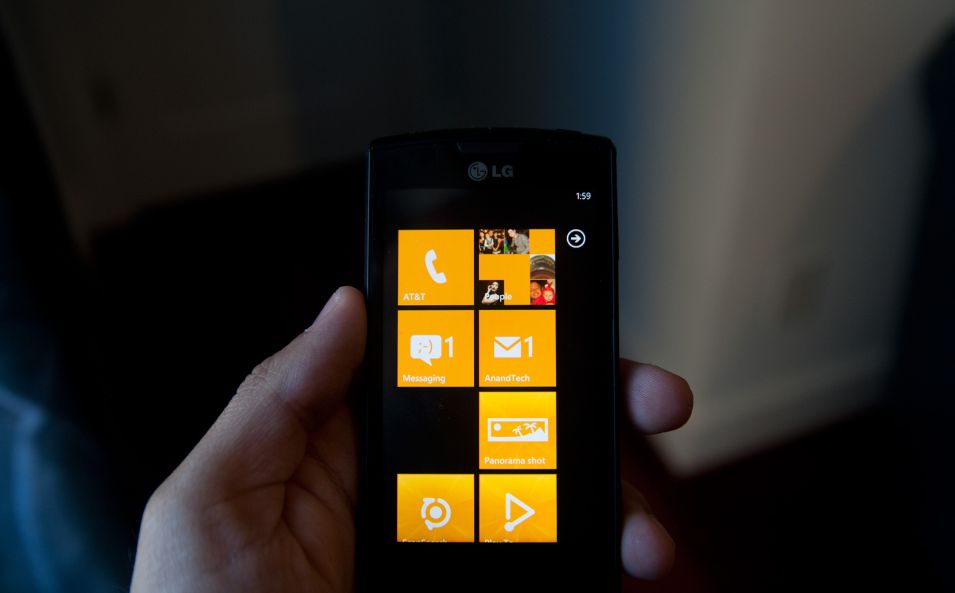
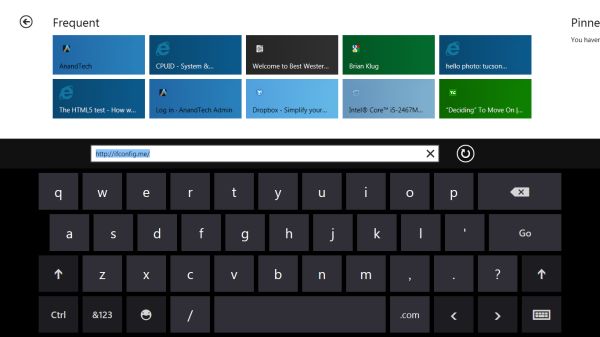
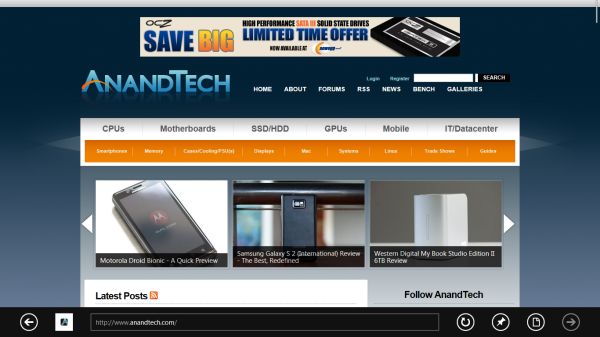
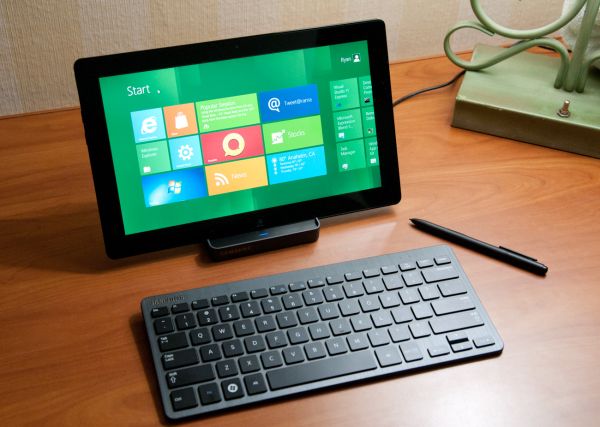
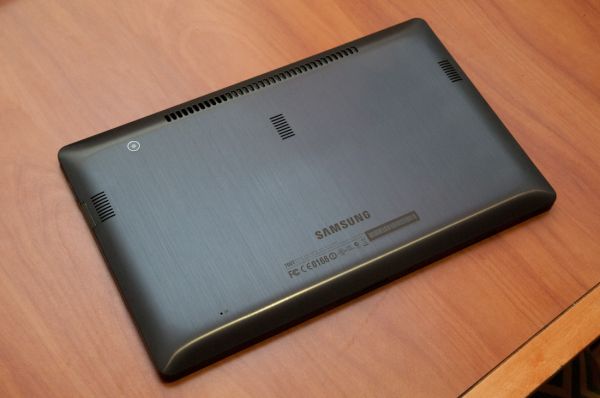
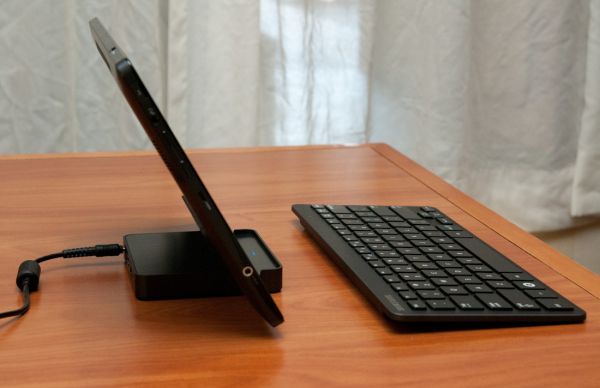








235 Comments
View All Comments
TEAMSWITCHER - Wednesday, September 14, 2011 - link
I'm sure it will be successful as all the other METRO GUI devices - Zune, Kin, WP7.Oh Snap!
UMADBRO - Wednesday, September 14, 2011 - link
Cool story, bro!Wraith404 - Thursday, September 15, 2011 - link
Hey, at least 100 people have accepted free WP7 phones.Krussll - Wednesday, September 14, 2011 - link
I like it, i think the Metro interface wil provide a much more harmonious windows experience for people who've adopted tablet computing but still use a windows PC for the most of their. I like the fact that it provides you with your key info on start up and is a short cut combo away when you need to check it, i think it has potential to be a great feature if developers can fully utilize it.I dont understand the people saying that it will be impractical for the mouse, umm you do have arrow keys on your keyboard i would have though that would have been obvious to use them.
thrasher32 - Wednesday, September 14, 2011 - link
I personally do not like the interface. I don't want a windows phone 7 look or OS on my desktop. I don't build $2000 gaming and production rigs to have the OS look like it's made for a 5 year old.Microsoft, you need to change direction now or you're looking at another Vista.
UMADBRO - Wednesday, September 14, 2011 - link
opinions = facts?smithg5 - Wednesday, September 14, 2011 - link
Take all of these purely negative comments, and replace "Metro" with "Desktop" and "Desktop" with "Command Line", and I'm sure you could have had the exact same conversation 15 years ago."You mean I always have to boot the desktop? It can't be disabled? I have to access the CLI from the desktop? Why would I use this on a server?"
The argument might be logical, but it clearly wasn't the end of the world then, and it won't be the end now. In fact, I think it's pretty great. Imagining system administration in 20-30 years, we all want some sort of swoopy sci-fi interface that's pretty and works well - this is the start of that.
It would be cool if they could Metrofy server management for simple environments.
UMADBRO - Wednesday, September 14, 2011 - link
At least someone around here is forward thinking and isnt stuck on almost 20 year old interfaces.Wraith404 - Thursday, September 15, 2011 - link
full screen, big blocks with no interactive multi-tasking is not forward thinking, it's a return to DOS 6.22 and the task swapper.Trying to drive desktop users to a tablet interface is doomed to fail. Windows are containers, they are required for productivity. In grown up land where we do real work, you often have to look at one application and act on another. Flipping between them in full screen would be horribly inconvenient. Metro might be neat, but it's for toys, period. I understand that Win8 can switch between them, but since the two modes clash horribly that's just not a desirable process. I have the preview installed, and disabled Metro already, simple as that.
ezodagrom - Wednesday, September 14, 2011 - link
The change from Command Line to Desktop was a good change, not just when it comes to aesthetics, but also when it comes to funcionality (multitasking).The change from Desktop to Metro, while good for tablets and other touch screen interfaces, it's just not as functional as a Desktop UI in desktops and laptops that don't have touch screen interfaces, especially when it comes to multitasking.